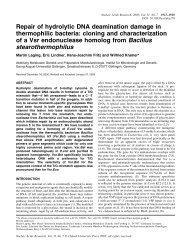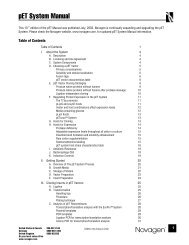DNA Mismatch Repair: Functions and Mechanisms
DNA Mismatch Repair: Functions and Mechanisms
DNA Mismatch Repair: Functions and Mechanisms
You also want an ePaper? Increase the reach of your titles
YUMPU automatically turns print PDFs into web optimized ePapers that Google loves.
<strong>DNA</strong> <strong>Mismatch</strong> <strong>Repair</strong> Chemical Reviews, 2006, Vol. 106, No. 2 313<br />
Mg 2+ , ATPγS‚Mg 2+ , or AMPPNP‚Mg 2+ . 92,232,243,248,285 Examination<br />
of the fate of radiolabeled ADP in [ 3 H]ADP‚<br />
MutSR <strong>and</strong> [ 3 H]ADP‚MutS complexes upon <strong>DNA</strong> binding<br />
has demonstrated that bound ADP is exchanged for ATP<br />
upon heteroduplex binding, 91,233 although homoduplex <strong>DNA</strong><br />
also promotes ATP for ADP exchange at 20-30% of the<br />
rate observed with heteroduplex. 19,91,246<br />
The mechanism of triphosphate-promoted dissociation<br />
from short heteroduplexes has been clarified by placement<br />
of physical barriers at ends of the linear <strong>DNA</strong>s. MutS <strong>and</strong><br />
MutSR dissociate rapidly from heteroduplex substrates with<br />
biotin tags at both termini upon challenge with ATP‚Mg 2+ ,<br />
but dissociation is blocked if the terminal biotins are bound<br />
to streptavidin. 232,233,238,284,288,289 Similarly, <strong>DNA</strong> structures<br />
such as four-way junctions <strong>and</strong> hairpins <strong>and</strong> protein‚<strong>DNA</strong><br />
complexes containing the Lac repressor or IHF, when<br />
strategically placed near substrate termini, also inhibit<br />
the ATP-induced release of heteroduplex-bound MutS/<br />
MutSR. 90,92,285,290 Thus, under conditions permissive for ATP<br />
hydrolysis, the dissociation of a MutS homologue from a<br />
short heteroduplex is presumed to occur at <strong>DNA</strong> ends. This<br />
effect, which has been interpreted in terms of movement of<br />
the MutS homologue from the mismatch <strong>and</strong> along the helix<br />
contour, led to the initial suggestion that MutS homologues<br />
may form a clamp-like structure about the helix. 232,233<br />
The formation of long-lived complexes on end-blocked<br />
<strong>DNA</strong>s in the presence of ATP‚Mg 2+ raises questions<br />
concerning the hydrolytic requirements for this effect.<br />
However, attempts to resolve this question have yielded<br />
contradictory results. In one study, challenge of end-blocked<br />
MutSR‚heteroduplex complexes with ATPγS or AMPPNP<br />
failed to yield long-lived complexes. 232 Similar results were<br />
obtained upon ATP challenge of such complexes with a<br />
mutant form of MutSR that binds ATP but is defective in<br />
hydrolysis. 288 These findings led to the conclusion that ATP<br />
hydrolysis by the <strong>DNA</strong>-bound MutSR is necessary to yield<br />
a mobile complex on <strong>DNA</strong> with the protein dissociating<br />
directly into solution if hydrolysis is blocked. However, a<br />
third study has demonstrated formation of the long-lived <strong>and</strong><br />
presumably mobile complex upon ATPγS challenge of endblocked<br />
MutSR‚heteroduplex complexes. 233 Preformed MutSR‚<br />
heteroduplex complexes used in the former two studies were<br />
prepared in the absence of nucleotide, while those used in<br />
the latter were prepared in the presence of ADP. It is not<br />
clear whether this experimental difference accounts for the<br />
differing results obtained in the three studies.<br />
The work summarized above has led to two models for<br />
ATP-dependent movement of MutS homologues along the<br />
helix, both of which have significant shortcomings. The<br />
electron microscopy studies of Allen et al. led to a model in<br />
which MutS movement along <strong>DNA</strong> is dependent on ATP<br />
hydrolysis by the <strong>DNA</strong>-bound protein. 231,232,245 The shortcoming<br />
of this model is that it is difficult to reconcile with<br />
the modest rate of ATP hydrolytic turnover by MutS<br />
homologues. An alternate molecular switch-sliding clamp<br />
model for MutS homologue movement has been proposed<br />
by Fishel <strong>and</strong> colleagues on the basis of two types of<br />
observations: 19,91,233,246 (i) the finding that under some<br />
conditions, ATPγS challenge of end-blocked MutSR‚<br />
heteroduplex complexes results in production of a long-lived,<br />
mobile complex, <strong>and</strong> (ii) the demonstration that binding of<br />
the ADP‚MutSR complex to heteroduplex <strong>DNA</strong> can be<br />
accompanied by ATP exchange for ADP. This two-state<br />
model envisions MutSR as a molecular switch in which<br />
exchange of ATP for ADP upon mismatch binding releases<br />
the protein from the mispair with the ATP form of the protein<br />
free to diffuse along the helix as a sliding clamp. 233,243 This<br />
proposal has two limitations. Implicit in this model is the<br />
assumption that only two nucleotide-bound states are highly<br />
populated, the ADP or ATP forms. However, as discussed<br />
above, there is excellent evidence that ADP‚MutS‚ATP <strong>and</strong><br />
ADP‚MutSR‚ATP complexes are also highly populated. This<br />
model also posits that formation of the ATP-bound sliding<br />
clamp form of the protein is sufficient to recruit a MutL<br />
homologue <strong>and</strong> activate downstream repair activities (see<br />
below). However, the mismatch dependence of ADP/ATP<br />
exchange is only 3-5-fold, 19,91,246 which is insufficient to<br />
account for the known specificity of activation of downstream<br />
repair functions. 82,93,108,182<br />
A hybrid proposal has been described that attempts to<br />
reconcile the shortcomings of these two models. This<br />
proposal invokes two <strong>DNA</strong> binding sites in the functional<br />
form of a MutS homolog, a clamp site through which <strong>DNA</strong><br />
may freely diffuse <strong>and</strong> a latch site, which serves as a<br />
reflecting barrier against which <strong>DNA</strong> diffuses through the<br />
clamp site. Because nucleotide occupancy is postulated to<br />
control the open/closed state of the latch, this model would<br />
support directional movement over a substantial distance with<br />
limited energy input. 232 However, there is no direct evidence<br />
that supports this idea.<br />
4.4. The (MutL/MutLr)‚(MutS/MutSr)‚<br />
Heteroduplex Ternary Complex<br />
The (MutL/MutLR)‚(MutS/MutSR)‚heteroduplex complex<br />
is generally believed to be a key intermediate in mismatch<br />
repair. Binding of bacterial MutS to a mismatch protects<br />
about 20 bp from <strong>DNA</strong>seI cleavage in footprinting experiments.<br />
68,78,90,251,291 In the presence of MutL <strong>and</strong> ATP this<br />
footprint exp<strong>and</strong>s to well over 100 bp, protecting <strong>DNA</strong> to<br />
both sides of the mispair. 80,92,251 It is not known whether the<br />
extended footprint is due to the binding of multiple copies<br />
MutL <strong>and</strong> MutS or wrapping of <strong>DNA</strong> about one of the<br />
proteins or whether <strong>DNA</strong> within the complex adopts an<br />
altered conformation that renders it less sensitive to nuclease<br />
attack. The striking nature of this complex is reflected in a<br />
<strong>DNA</strong> chain length requirement for its formation. Although<br />
specific (MutS/MutSR)‚heteroduplex complexes are readily<br />
formed with <strong>DNA</strong>s as short as 20 bp, formation of the E.<br />
coli MutL‚MutS‚heteroduplex <strong>and</strong> the human MutLR‚MutSR‚<br />
heteroduplex ternary complex is most efficient with <strong>DNA</strong>s<br />
on the order of 100 bp or larger. 90,234<br />
In addition to footprinting methods, (MutL/MutLR)‚<br />
(MutS/MutSR)‚heteroduplex ternary complexes have been<br />
studied by electron microscopy, gel shift, <strong>and</strong> biosensor<br />
methods. 88,90-92,176-178,231,234,256,258,285 These studies have led<br />
to contradictory conclusions concerning the nature of the<br />
complex, <strong>and</strong> it is fair to say that it is not well understood.<br />
Although the consensus view is that ATP is required for<br />
ternary complex formation, the dynamics of the complex <strong>and</strong><br />
ATP hydrolytic requirements for its formation are the subject<br />
of debate.<br />
Several biosensor studies of ternary complexes in the E.<br />
coli, yeast, <strong>and</strong> human systems have indicated that assemblies<br />
are dynamic, undergoing rapid dissociation in the presence<br />
of ATP‚Mg 2+ or in the absence of nucleotide. 88,234,258,285<br />
These observations coupled with the finding that at least<br />
some ternary complexes can be trapped on linear heteroduplexes<br />
with physical barriers at both termini has led to the




